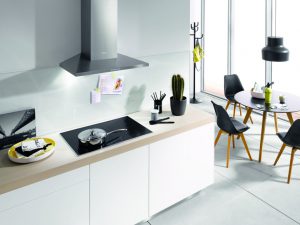Choose Your Range Hood
Range hoods are available in a variety of sizes and designs, so you’ll need to choose the right hood for your kitchen. You will need to make your decision based on how your kitchen is set up and how much you cook. If you have clear space above your cooktop, you can install a wall mounted hood, island or sophisticated chimney design. Whereas, if your cooktop is installed directly under your cabinetry, you’ll need an under cabinet hood. This type of hood tends to be easier to install since they don’t usually require duct work leading outside your home. It is important to note that many under cabinet hoods recirculate rather than vent the air, so it may be as effective.
Consider Safety
You’ll need to take adequate safety precautions before starting any work. Turn off the power supply to your kitchen and lock your panel box to ensure that the power isn’t turned back on inadvertently before you’re finished. You should also wear gloves, a mask, and goggles while you’re working.
Check Your Vents
If you’re planning on installing a vented hood, you will need to check your vents to ensure that you have the proper ductwork and your choice of hood matches it. An under cabinet hood is likely to have ducting in the back of the wall or running through the cabinet above. If you need new venting for your hood, ensure that it leads out of the house and doesn’t end against a wall or in the attic, or there is a risk of heat buildup that could create a fire hazard.
Remove the Old Hood
If you have a current range hood, you will need to remove it. This is likely to involve disconnecting the wires behind the panel. You’ll also need to loosen the screws attaching an under cabinet hood to the cabinet above. Just be sure not to remove it completely as you should be able to slide the hood before removing the screws completely.
Check Your New Hood Fitting
Now, you’ll need to check your new hood will fit in the space. Depending on your stove and hood to ensure that it is 20 to 30 inches above the stovetop. Your hood should hang slightly lower for an electric stove. The range hood should cover the entire cooking area with an overhang of approximately 3 inches on all sides, where possible.
Connect Your New Hood
Holding the hood in place, thread the wires from the wall through the back of the small hole in the hood. You’re likely to see a black and a white wire from the wall and two black and two white coming from the new hood. Using wire connectors, connect the black wires from the new hood to the wall and the white hood wires to the white wire from the wall. Tuck the excess wire and replace the panel cover. Use the manufacturer recommended screws to fix the hood in place. Ensure it is secure before you turn the power back on. Test the range to ensure that the new hood is functioning properly.
If you’re unsure whether you can tackle installing a new range hood yourself, you can rely on a professional appliance installation technician to help you. For help will all your appliance installation issues, be sure to speak to a professional appliance installation and repair service.
